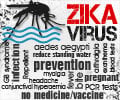Highlights
- Rapid mutations in Zika virus serotypes may turn all the developmental vaccines and diagnostic tests invalid.
- The Emergent Final stage pathogen was very different from the invading virus pathogen
- In men, Zika virus can replicate in their testicular cells infecting the sperms
- The sexual transmission of zika virus greatly increase its capacity to spread
For months, the team closely monitored three asymptomatic patients - two men and a woman - and collected samples of the patients’ blood, saliva, and urine, as well as semen in the case of the two men, every week.
The material was sent to the United States, where whole-genome sequencing of the virus was performed with the help of the US Army.
"Week by week, we examined the data to see what was different in the viral genome," Durigon said. "In one patient, we found compartmentalized strains: the virus present in his semen was different from the virus in his urine.
In all cases, the pathogen we found in the final stage of the infection wasn’t the same as the virus that entered the patient."
"Zika continued to replicate in the patient’s testicular cells all this time, and using an electron microscope, we could see that the spermatozoa were formed already infected," he said.
The possibility of sexual transmission greatly increases Zika virus’s capacity to spread, Durigon added, stressing that in his view, medical culture must change, as the profession still focuses on antenatal care for women.
"It’s no use testing only pregnant women to see if the virus is present, and advising only women to use insect repellent and avoid high-risk areas during pregnancy, while leaving men to go on with their lives as normal," he said.
"Women could be infected by their partners. Doctors aren’t paying attention to this possibility."
Serological test
During his presentation, Durigon recalled how Rede Zika was set up in São Paulo and how the swiftly organized network linking the scientific community and FAPESP ensured the advance of knowledge about Zika.
"The virus was first isolated in Brazil in November 2015 by Pedro Vasconcelos, a researcher at Evandro Chagas Institute in Pará.
Our group at ICB-USP requested a sample, which arrived by mail while we were still putting up Christmas decorations," Durigon said.
Researchers in São Paulo State then went into action. Between 2000 and 2007, they were part of the Viral Genetic Diversity Network (VGDN), a project supported by FAPESP that enabled an important infrastructure for virological research in São Paulo.
"In 2015, many members of that network had ongoing projects on other subjects with support from FAPESP," he recalled.
"The agency quickly approved additional funding for these projects, and all efforts focused on the study of Zika.
As a result, we were soon able to grow viral isolates in the lab and distribute them to several research groups around Brazil."
According to Durigon, the scientific community’s swift response in São Paulo inspired groups in other states as well as other research funding agencies, enabling the creation of a nationwide Zika network.
The advances achieved since then include
- The development of molecular diagnostic tests (capable of detecting viral RNA in samples taken from patients during infection), proof that the virus causes a congenital syndrome that may or may involve microcephaly
- the development of experimental vaccines
- the validation of a serological test that detects antibodies against the virus in blood samples even after the infectious stage is over
"We’ve validated it in over 1,000 samples from the population of São José do Rio Preto in the interior of São Paulo State, and in 800 samples from patients in Salvador, Bahia, including women who had children with and without microcephaly and patients who had yellow fever and dengue. If this test can identify Zika in Salvador, it can work anywhere in the world."
The team that developed the serological method also includes ICB-USP researchers Paolo Zanotto and Luís Carlos de Souza Ferreira
The next step, according to Durigon, is to collect more samples in São Paulo State and its capital to find out how many people have actually been infected to date in the region.
Because up to 80% of cases may be asymptomatic, without the serological test, it is impossible to know the real magnitude of the epidemic and the percentage of the population that is still susceptible to the virus.
"São Paulo has apparently had few cases of Zika so far," he said. "In Salvador, the tests are showing that a large proportion of the population has already been infected, including pregnant women, and that’s why there have been many cases of microcephaly.
Bahia, Pernambuco, and Paraíba will probably have few cases for at least four years or so until a significant proportion of the population is susceptible again. In São Paulo, we don’t yet know."
The main concern today, he added, is children born to mothers who are infected unawares by Zika during pregnancy. "These children may have brain damage but not microcephaly, so they won’t be carefully monitored.
The problem won’t appear until later when they start displaying motor or learning difficulties. We could have a generation of children with all kinds of complications, and we won’t know how to deal with them."
As soon as the serological test is available on a large scale, the largest possible number of children born during the period should be tested.
Positive results should be assessed with caution and confirmed by imaging. "What we’re seeing is just the tip of the iceberg. We don’t know what’s underneath," he said.
Reference:
-
New Zika serotypes may emerge, researcher warns
- (http://agencia.fapesp.br/new_zika_serotypes_may_emerge_researcher_warns_/26306/)
Source-Eurekalert












